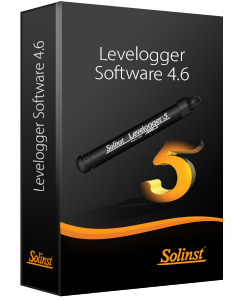This section describes how to perform manual barometric compensation on Levelogger 5, Levelogger 5 Junior, Levelogger 5 LTC, Levelogger Edge, Levelogger Junior Edge, and LTC Levelogger Edge data files when a Barologger was not dedicated as a barometric recorder.
Note:
For Manual Barometric Compensation instructions for the Levelogger Gold and Levelogger Junior, visit: www.solinst.com and see the Levelogger Software Version 3.4.1 User Guide in the Downloads section.
For short term tests during which the barometric pressure varies insignificantly, the collection of continuous barometric data may be unnecessary. In this event, take a reading from an open air exposed Levelogger prior to running the short term test and record this level. This level represents the barometric pressure. Similarly, at the end of your test, take another barometric reading and record this measurement. After the submerged Levelogger data has been exported to a spreadsheet program, compensate your submerged Levelogger data files for barometric pressure. If no appreciable change in barometric reading occurred, you may write in the first cell of a new column, a simple calculation that subtracts your barometric reading from the submerged data file, then copy and paste this calculation to all the cells in that new column. The new column will represent the barometrically compensated liquid level.
Note:
When analyzing barometric data it is important to keep in mind that storm events commonly reduce total atmospheric pressure by about 1.7% from pre-existing high pressure conditions. 1.7% converts to approximately 0.2 m or 0.6 ft of water level equivalent barometric fluctuation.
Barometric data can be collected on site using a recording barometer or from a local weather station. To accomplish an accurate manual barometric compensation, the atmospheric pressure station should not be greater than 30 km (20 miles) away). In addition, the date and time of the barometric data should cover the range of data collected by the Levelogger. If setting up the barometer, set the recording interval to that of the Levelogger sampling interval or some multiple of the Levelogger interval.
Note:
It is important to remember that weather station barometric data will often contain an offset or normalization (i.e. normalization to sea level). Manual data conversation and barometric compensation should account for any variation of the normalization or offset used between the barometric data sourced and Solinst Leveloggers.
Note:
See our Technical Bulletin: Barometric Compensation and the Importance of Barometric Data, for more information on incorporating elevation differences in your compensation.
To compensate submerged Levelogger data using barometric data collected from an on site barometric datalogger or a nearby weather station, these steps must be taken:
- Export both the Levelogger data file and the barometric file to a spreadsheet.
- In the spreadsheet, ensure both files are using the same units. If your Levelogger data was recorded in m, cm, or ft, convert the barometric data column from its barometric measurement units (typically atm, mm Hg, psi, mbar or kPa) to feet or meters of water column equivalent using the conversion factors in Table 8-1. (There is also the option to initially set up your Levelogger Edge or Levelogger Junior Edge to record in psi, kPa, or bar. This makes compensation using other atmospheric pressure devices easier.)
Note:
You can also convert the Levelogger 5 data units to match the Barometric units using the Data Wizard.
Common barometric units to water column equivalent conversions |
||
|---|---|---|
Barometric unit |
Water column equivalent (ft) |
Water column equivalent (m) |
1 psi |
2.30666 |
0.703070 |
1 kPa |
0.334553 |
0.101972 |
1 mbar |
0.0334553 |
0.0101972 |
Table 8-1 Common Barometric Units to Water column Equivalent Conversions
- Once the units for each column are the same, subtract the barometric column from the Levelogger data to get the true net water level recorded by the Levelogger.




